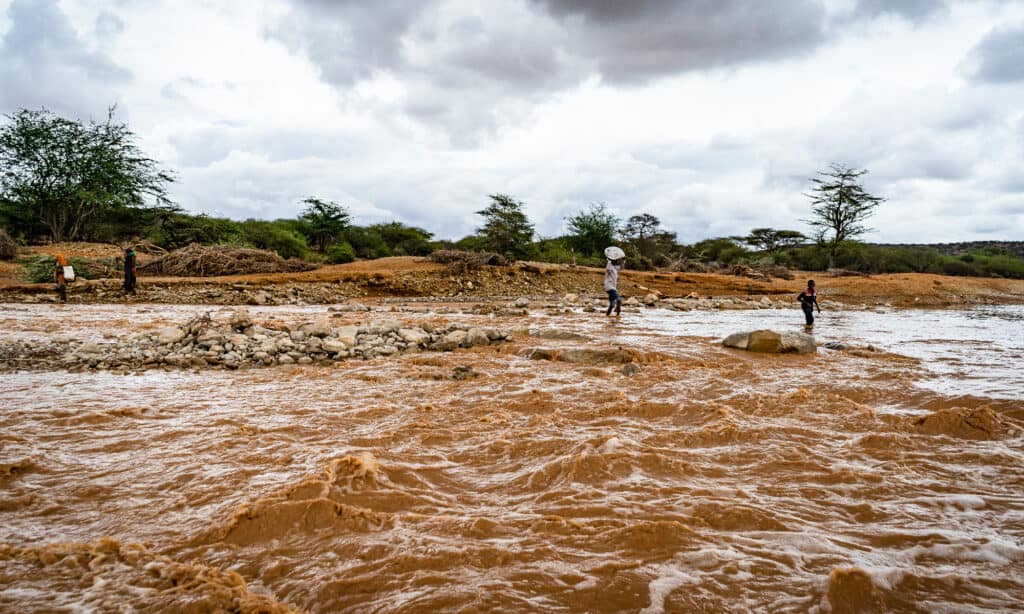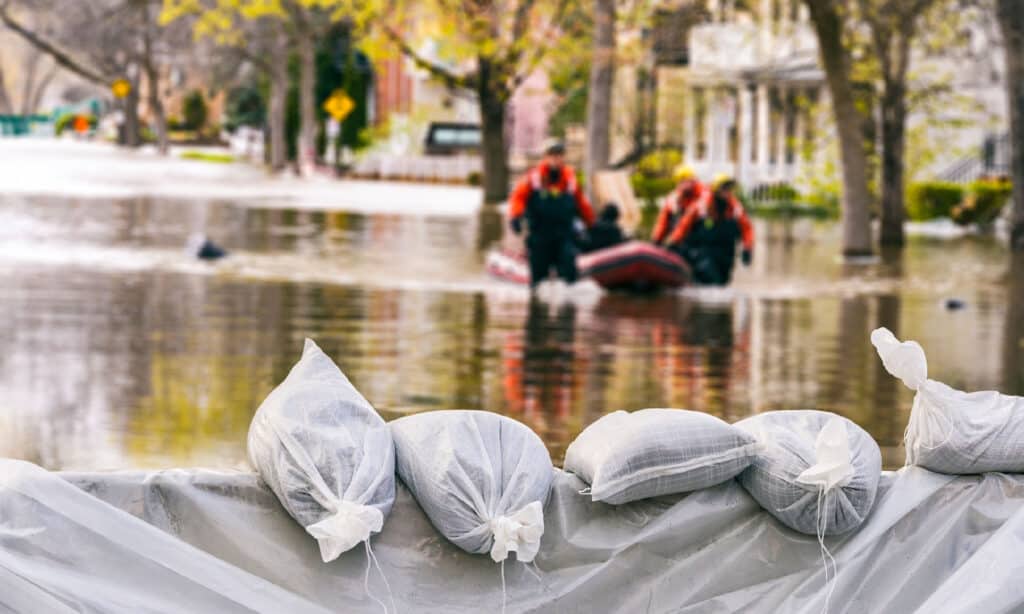Natural disasters often come without any warning and destroy everything in their path. Flash floods are one of these natural disasters and can be extremely deadly. The rapid flow of raging water in low-lying areas that rises due to a dam break, heavy rainfall, or excessive discharge of high water in rivers can cause flash floods.

Rainwater gathers in low-lying areas, blocking roads in the process.
©Danaan/Shutterstock.com
These events put people’s lives, belongings, property, and environment at high risk, and can lead to fatalities, geographical destruction, and homelessness. Due to the number of factors that contribute to flood risk, flash floods are difficult to forecast. We listed the top eight deadliest flash floods in history according to the devastation they caused.

Raging flood waters easily devastate small villages.
©Stanley Dullea/Shutterstock.com
India
August 11, 1979, was probably one of the most horrible days in the history of India as one of the deadliest flash floods of all time took place. The flood occurred in the state of Gujrat. The Machu Dam burst with rainwater after holding it for many days, causing 12- and 13-feet high waves that destroyed the low-lying areas beneath the dam.
Water covered the city of Morbi within 20 minutes, which caused a horrific number of deaths, totaling around 1800-2500 people. Additionally, the destruction of properties, agricultural lands, and crops caused widespread suffering. Therefore, The Guinness Book of World Records calls this tragedy the worst dam break event in history.
Kentucky’s Heaviest Rain
Many residents of Kentucky remember the worst event in their state’s history, which occurred in 1997. After heavy rainfall from March 1-3, a flash flood demolished properties and houses, while stealing several lives. As a result, this was the worst flood in the history of Kentucky.
The low-pressure center of western Kentucky associated with the warm sector. Intense cold associated with the low-pressure movement of the Northeast also contributed to the storm. Because of these factors, rain drenched southern Indiana and northern Kentucky with about 1 foot of water.
This deadliest flash flood destroyed almost 14,000 homes in Kentucky and was responsible for 33 fatalities. The damage was beyond repair, with losses totaling 500 million dollars. The flood also affected unsuspecting drivers and their vehicles, adding another dozen fatalities to the list.
Raging water swept several people away, while rising floods trapped others, causing severe injury and loss of shelter. Due to these factors, it was one of the deadliest flash floods of all time.
Pennsylvania
The Johnstown Flood occurred on May 31, 1889. This Pennsylvania tragedy is the second deadliest and most horrific flash flood in the history of the United States. The South Fork Dam, located in the Little Conemaugh River, broke after seven days of heavy pouring. Then, 20 million tons of water flowed quickly into the city, killing around 2,209 people.

Search and rescue teams navigate dangerous conditions to assist flood victims.
©iStock.com/Marc Bruxelle
Pakistan
In July and August 2010, at the peak of monsoon season in Pakistan, the third deadliest flash flood occurred. Heavy rain poured throughout Sindh, Khyber Pakhtunkhwa, Balochistan, and Punjab region.
Around 20% of the geographical area of Pakistan was affected. More than 20 million people lost their properties, homes, crops, and agricultural lands. Furthermore, this natural disaster killed around 1400 people.
Portugal
In 1967, severe flash flooding battered Lisbon, which is surrounded by rivers and oceans. Rain fell at an incredible rate of 1.2 inches per hour. As a result, surrounding waterways overflowed and wiped away villages and cities. Fortunately, most of these areas had been evacuated.
This deadly flood destroyed the lifestyle of the residents, along with private businesses, cars, houses, and other properties. In addition, more than 465 lives were lost. The Lisbon flood was the fourth deadliest flash flood in the history of the world and the second deadliest natural disaster in Portugal.
Big September Rain
The horrific event of Big September Rain occurred from September 22-23, 2006. Also known as the Bluegrass Flood of 2006, this harsh weather affected Louisville and the southeastern United States.
Officials closed the interstate and Monon Road in Orange County, and the bridge of Cooperstown was impossible to cross. Indiana, Logan County, North Russellville, and Kentucky were also under water. The water was 6 inches in some areas, based on radar and personal accounts.
Indiana saw 2.5 inches of rain in just an hour, according to rain gauges. The damage was extensive. Rampant flooding destroyed property totaling a million dollars. Residents evacuated their apartments and homes in Louisville, as many were forced to flee very quickly in order to survive, leaving their houses, belongings, and cattle at the mercy of surging water.
After the flood of March 1997, the September Rain was the deadliest rain flood in history. Half a dozen people died.

Vehicles may be destroyed by rising water, or even swept off roads.
©Teerapong Yovaga/Shutterstock.com
Allen County Flood
The June 23, 1969, flood in Allen County, KY, and Red Boiling Springs, TN, was yet another deadly natural disaster. The line of thunderstorms from different parts of north-central Tennessee and south-central Kentucky was initially slow-moving. This low-pressure system moved from Chicago to the west of Tennessee and Kentucky, along with a cold front and warm air mass.
Due to these conditions, more than 8 inches of rain fell in Kentucky within six hours. In Allen County, Trammell Creek overflowed, resulting in the loss of three lives and property damage of around 30 million dollars.
A record-breaking 2 inches of rain fell in Scottsville between 4 a.m. and 5 a.m. Although many areas were affected, Red Boiling Springs, Allen County, and Tennessee saw most of the damage.
Louisville’s Wettest August Day
August 4, 2009, was yet another doomsday when a deadly flood flowed through central Kentucky and southern Indiana, along with a thunderstorm. Jeffersonville, Louisville, Clarksville, and New Albany were the areas most affected.
Rising flood water wiped out roadways and bridges. Prominent structures like Churchill Downs and the University of Louisville were among the most affected places. Adding to the havoc, lightning struck Hurst Bourne Lane, resulting in fire.
Additional flooding occurred in the afternoon with thunderstorms and heavy rain in the Lexington and Bluegrass region. The highest rainfall was recorded at Stanford International Airport, at 4.55 inches, which broke previous daily rainfall records in the region. Impressively, it poured up to 3 inches in just one hour.
Up Next…
Take a look at some of our other articles about deadly natural disasters.
- Why Do Plagues Of Snakes And Spiders Follow Floods? – Find out the real reason you are seeing them!
- 7 Strongest Hurricanes Ever Recorded – Read about the devastation these caused.
- Why Are Volcanic Tsunamis So Dangerous? – The real reason might surprise you.
The photo featured at the top of this post is © BONNIE WATTON/Shutterstock.com
Sources
- Weather, Available here: https://www.weather.gov/lmk/top10flash
- World Atlas (1970) https://www.worldatlas.com/articles/some-of-the-deadliest-flash-floods-the-world- witnessed.html
Thank you for reading! Have some feedback for us? Contact the AZ Animals editorial team.






